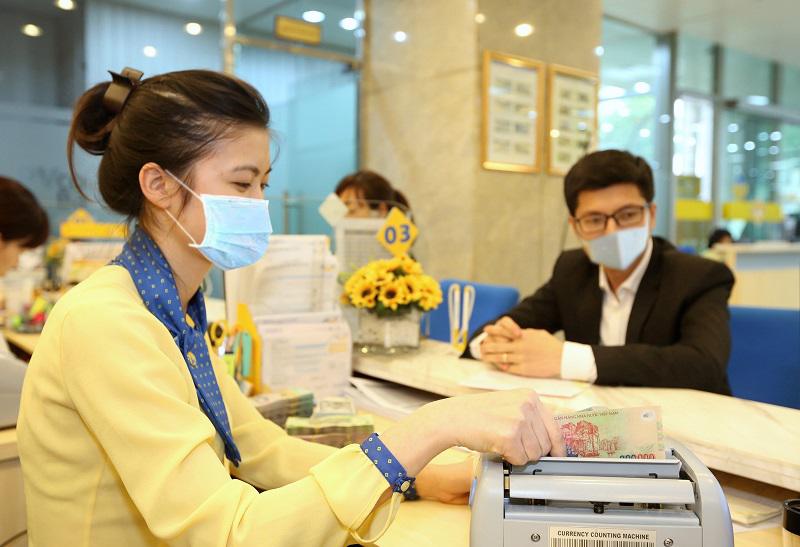Favorable conditions to boost credit growth in 2022
Favorable business conditions and ample liquidity would lead to robust credit growth in the first half of 2022.
In various scenarios of the pace of recovery, it is anticipated that business conditions will improve in 2022. This should ease the perceived credit risk of the economy and therefore, boost credit demand as well as supply.
| A customer at a PVComBank's branch in Hanoi. Photo: Pham Hung |
“This, combined with the current ample liquidity, is expected to boost credit growth in the first half of 2022,” stated the Viet Dragon Securities Company (VDSC) in its latest strategy report.
Vietnam’s credit growth as of December 22, 2021, expanded by 12.68% against late 2020 and 14.57% year-on-year amid the severe Covid-19 impacts.
According to VDSC, ramping up economic activities would also bring better circulation through payment and investment demand and thus, supporting deposit growth. Meanwhile, corporate deposits might expand slower than in 2021 while retail deposits bounce back, facilitating funding base expansion of retail-oriented banks.
Given Vietnam’s expected “K-shape” recovery, the report suggested uneven credit and deposit growth between banks due to different customer segments and the ability to overcome short disruptions.
On the other hand, changing customer behavior in a new normal is set to bring institutional changes in the funding structure, stated the VDSC. “The intense and enduring periods of social distancing would lead to changes in consumer behaviors. It also changes how people deposit their savings and therefore, requires financial institutions to cope with the new behaviors of cash flow. Forecasting behavioral maturity becomes more essential to prepare for the new normal.”
This would result in enduring changes in the deposit structure of certain banks. In the meantime, when deposit rates are still maintained at a low level and more efforts are put into transforming to the cashless economy, VDSC expects the current account savings account (CASA) ratio to continue trending upward. Growth rate and volatility will differ among banks based on customer segments and types. Higher CASA will enhance net interest margin (NIM), reduce costs including operating expenses, and ultimately result in better efficiency.
VDSC also noted bancassurance upfront fees have become a disruptive earnings booster due to the increase in pricing.
“Coming to 2022, quarterly earnings volatility might sustain at some banks as a result of this,” it added.
The card segment was hit because of social distancing. Trade finance was also somewhat interrupted. Online transactions and payments continued to rise, while bancassurance fee income was polarized among banks due to their technology base. The recovery theme will enable non-interest income growth at retail-oriented banks.
Pandemic unpredictability a key challenge
The pandemic outbreak in late 2021 was somewhat not a consensus expectation. Many provisioning plans of banks were adjusted materially, which proves the uncertainty of the Covid-19 pandemic.
With the conclusion of the pandemic being uncertain, which means the non-performing loan (NPL) formation is forecast with an unknown level of significance. Furthermore, the NPL formation rate during the aftermath of the shock given the event of a foreseeable pandemic conclusion is still volatile, even when benchmarking the prior crises.
A survey conducted by the State Bank of Vietnam (SBV) revealed commercial banks also are willing to loosen their risk appetite following the economic recovery and depending on actual progress. VDSC, therefore, expected credit growth to be boosted gradually towards the end of the year on the basis that the economic recovery support package is steadily disbursed.
On a favorable macro background, the securities company predicted banks to continue posting well performance.
In this regard, state-owned banks will have polarized growth rates, and highly volatile quarterly earnings, while private banks are expected to have a gradual recovery in growth towards year-end, with the timing for high growth is expected to be in the second and third quarters of 2022.
“We expect large private commercial banks to have better growth rate and growth quality than small banks. Supporting factors include dividend payment, private placement, capital increase, foreign ownership cap loosening, and bancassurance upfront fees are polarized among the sector, but still concentrates more in the group of medium-sized banks and above,” it noted.
The state-owned banks, on the other hand, would be supported by stories such as dividends and private placement to foreign investors’ expectations in the first quarter.












